| Last Letter from Hog Island |
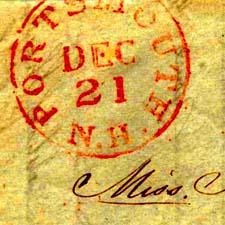 APPLEDORE ISLAND 1847
APPLEDORE ISLAND 1847
In December 1847 a 12-year old girl wrote to a friend. She wrote from Hog Island at the Isles of Shoals. Her father was building a hotel there. It would become the meeting-place of famous writers and painters and musicians for decades to come. The island would be renamed Appledore. But in 1847 Celia Laighton was focused on her reading, her cats, her cow and a teacher named Levi.
READ the entire 1847 letter by Celia
At first glance the earliest known writing by Seacoast poet Celia Laighton Thaxter is a bland little thing not much larger than a playing card. Written at the Isles of Shoals and postmarked four days before Christmas in 1847, the letter is folded five times from a single large sheet of watermarked paper. The final crease is slightly off kilter, not through carelessness, but by design. The 12-year old author tucked the smaller end neatly into the larger one and affixed the two sides with a blob of red wax. There is no envelope or stamp. The back of the letter is addressed to Celia’s child friend Miss Martha Kuhn of Boston, Massachusetts.
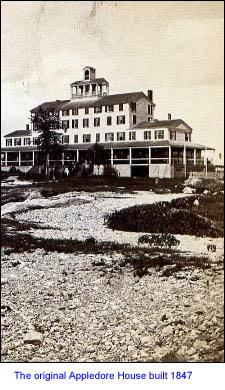 I have the letter in my hand, a gift of David Jaret of Pennsylvania. He bought it in an online auction from a man in Shrewsbury, Massachusetts. The seller was interested only in the early "stampless" postmark. David was curious, he says, about the content of the message written from an island so long ago. When I wrote to ask him if, just by chance, the author might be Thomas Laighton, a Portsmouth entrepreneur who built a hotel at the Isles of Shoals in 1847, David called me on the phone. Sorry, he said. The letter is simply signed "Celia", but with no last name. A message appended in a different hand, however, was initialed "TBL". I knew instantly that this letter was something very special.
I have the letter in my hand, a gift of David Jaret of Pennsylvania. He bought it in an online auction from a man in Shrewsbury, Massachusetts. The seller was interested only in the early "stampless" postmark. David was curious, he says, about the content of the message written from an island so long ago. When I wrote to ask him if, just by chance, the author might be Thomas Laighton, a Portsmouth entrepreneur who built a hotel at the Isles of Shoals in 1847, David called me on the phone. Sorry, he said. The letter is simply signed "Celia", but with no last name. A message appended in a different hand, however, was initialed "TBL". I knew instantly that this letter was something very special.
The exquisite handwriting inside is miniscule and tightly drawn as if penned by a doll. The return address is Hog Island, renamed Appledore Island the following year when Celia’s father Thomas opened his Appledore House hotel there. In the letter Celia says that her father has been building a large house with a hundred windows. She complains to her friend Martha that noise of the carpenters hammering bothered her at first, but she has grown used to the sound. For the previous eight years Celia had grown up in the lighthouse on White Island nearby with two brothers Oscar and Roland.
We know Celia’s childhood story from her own memoir, "Among the Isles of Shoals" published in 1873 during her rise to national literary prominence. The book is still in print today. This new letter shows us an incredibly sophisticated child, speaking in her own voice. Although her mother Eliza was likely illiterate, Celia was home-schooled by her father Thomas, formerly an editor of the NH Gazette, a failed politician and businessman. The letter begins:
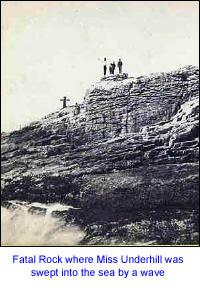 "My dear Martha, I have but a moment since received your second kind letter, and I must beg you to forgive my almost unpardonable negligence in not Answering the first before. I had just finished a letter to you, when the boat that brought your last came."
"My dear Martha, I have but a moment since received your second kind letter, and I must beg you to forgive my almost unpardonable negligence in not Answering the first before. I had just finished a letter to you, when the boat that brought your last came."
Remember, this writer is 12. Already an accomplished storyteller, Celia writes to Martha of her Christmas plans, and about an old fisherman, and about a woman named Mrs. Johnson with a pale complexion. We learn that she has been reading two novels by Sir Walter Scott and two books by Hans Christian Anderson. She loves to sing, has learned "Flow Gently Sweet Afton" and wishes she could attend a concert by the Swedish nightingale Jenny Lind, then touring the country.
Celia writes about her red cow Juno and an "amiable" woman named Miss Underhill who is sewing the bedsheets for the opening of the hotel next year. Shoals’ visitors all know that Miss Underhill, was later surprised by a large wave and swept to her death at sea.
CONTINUE to read about HOG ISLAND LETTER
Appledore Letter from Celia Thaxter, Aged 12
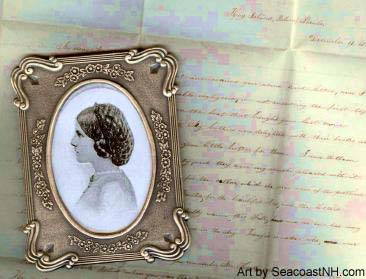
Another passage about Celia’s new kittens is especially well crafted.
"We have three kittens all very pretty, that run about the Island, and sleep under the rocks, for they will not come into the house. They will let my brothers and myself play with them, but they will let no one else touch them. They live principally on the wild birds and crabs that they find in large quantities here. One of the kittens is particularly handsome. She is as black as black can be and has eyes almost ovoid. She is very intelligent and will stand and hold her paws to catch anything we give her."
Three times Celia mentions her Boston tutor Mr. Levi Thaxter. He has been helping her press sea moss. He has a Newfoundland dog named Luria. She tells Martha:
"Do you remember Mr. Thaxter, one of the gentlemen that were at White Island when you was there? The one that performed the lady. He teaches my brothers and myself now."
Until this letter appeared, the oldest surviving correspondence of the "Island Poet" dated from March 1851 more than three years later. By then, the 15-year old Celia wrote to her friend Jennie Usher about her impending marriage to Levi Thaxter, a man 11 years her senior.
"Perhaps you do not know who Mr. Thaxter is," Celia wrote. "He is the gentleman whose wife I shall probably be this fall.
The passage, according to Celia scholar Stephanie Nugent is cryptic, elliptical and haunting. We never truly know how Celia feels about what appears to have been an arranged marriage between her father and Mr. Thaxter, who was Thomas Laighton’s business partner for a short time and who loaned him $2,500 on the eve of his engagement to Celia.
We do know, from recently discovered letters by Levi, that he had his eye on the young girl as a potential mate by the time she was 12, when he was 23. Married at 16, Celia Thaxter was taken away from her beloved island. Nine months later she returned to Appledore where her first child Karl was born. Karl suffered with physical and emotional problems that kept him in his mother’s care for the rest of her life. Celia quickly had two more sons, and although she and Levi never divorced, the marriage quickly faltered and the two lived separately.
"What did she think of her marriage to Levi?" Stephanie Nugent asks today. "This new letter helps me build my answer to the question."
Stephanie, who also portrays Celia in a popular one-woman theater production, notes that in this 1847 letter, Celia appears to be responding, point by point, to questions from her mainland friend Martha. Celia, however, leads the letter with news of Mr. Thaxter and mentions him twice more.
Jane Vallier of Iowa State University, a long time devotee of Celia’s writing, says she has always seen the young girl’s engagement to the older, brooding Mr. Thaxter of Boston as "a rather dark and gothic affair." Jane asks – "Was Celia the wunderkind and he the evil educational experimenter? Did he get engaged to get his parents off his back about settling down?"
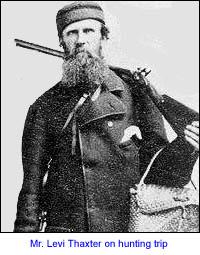 The letter does indicate that the little Portsmouth-born girl, raised in isolation in an island lighthouse, was at least fascinated by the worldly Mr. Thaxter. We can also see that, even before his influence as a tutor, Celia’s artistic and social skills were highly evolved. The 1847 letter demonstrates too how much Celia had learned from her father Thomas, an educated and well-spoken man, before Levi became her tutor. Levi may have corrected her grammar and fostered her talents, but he did not invent her.
The letter does indicate that the little Portsmouth-born girl, raised in isolation in an island lighthouse, was at least fascinated by the worldly Mr. Thaxter. We can also see that, even before his influence as a tutor, Celia’s artistic and social skills were highly evolved. The 1847 letter demonstrates too how much Celia had learned from her father Thomas, an educated and well-spoken man, before Levi became her tutor. Levi may have corrected her grammar and fostered her talents, but he did not invent her.
"The 1847 letter is fascinating," says Norma Mandel, author of the most recent Celia biography, "Beyond the Garden Gate". "Celia's language is mature for a teenager at any time. I think it shows not only Levi's influence, but reflects the atmosphere in which she grew up. While her mother may have been illiterate, her father certainly was able to impart an exceptional love of language to her. Celia herself was like a sponge, absorbing whatever the visitors to the islands had to provide."
The most significant part of the discovery, Norma says, is that it confirms what we already know – that the facts are just as Celia presented them in her later writing. And we now know that from the beginning, she says, Levi Thaxter "was very much a welcome part of her life".
Through the amazing world of Internet auctions, Celia’s letter has come home. When I asked David Jaret if I might see a Xerox or computer scan of the letter, he sent me the original the next day by Federal Express. Rather than sell it for profit or store it in his collection, Jaret thought the letter would be most appreciated in Celia’s birthplace. I donated it in Jaret’s name to the Portsmouth Historical Society, and it will be archived at the Portsmouth Athenaeum, just a block from where Celia was born..
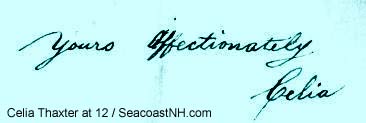
"I had never heard of Celia Thaxter until I got your note and read about her on your web site. Then I talked to a couple of friends who are historians," David Jaret says. "They told me just to give the letter to the people who could appreciate and care for it best. It seemed like the right thing to do. I wanted it to be seen by the public."
"Do you have any idea how much this item is worth?" The expert asks the owners this question time and again on the popular PBS TV-series "Antiques Roadshow." The value of history, we are told, can be translated directly into dollars. And so it is painful, time and again, to see local artifact collections broken up and sold in online auctions. But sometimes we win one, and every piece of the puzzle helps. If all politics are local, as Tip O’Neil was fond of saying, then all history is local too. David Jaret’s little gift makes that wonderfully clear.
Copyright © 2006 by J. Dennis Robinson. All rights reserved. Originally published here in 2003.
J. Dennis Robinson is editor and owner of the regional Internet portal SeacoastNH.com containing thousands of web pages of local history and culture. Essays by Robinson, Jane Vallier, Norma Mandel and others appear in the book "One Woman’s Work: The Visual Art of Celia Laighton Thaxter" edited by Stephanie Nugent, published by Peter E. Randall, Publisher and available at the Portsmouth Athenaeum.
